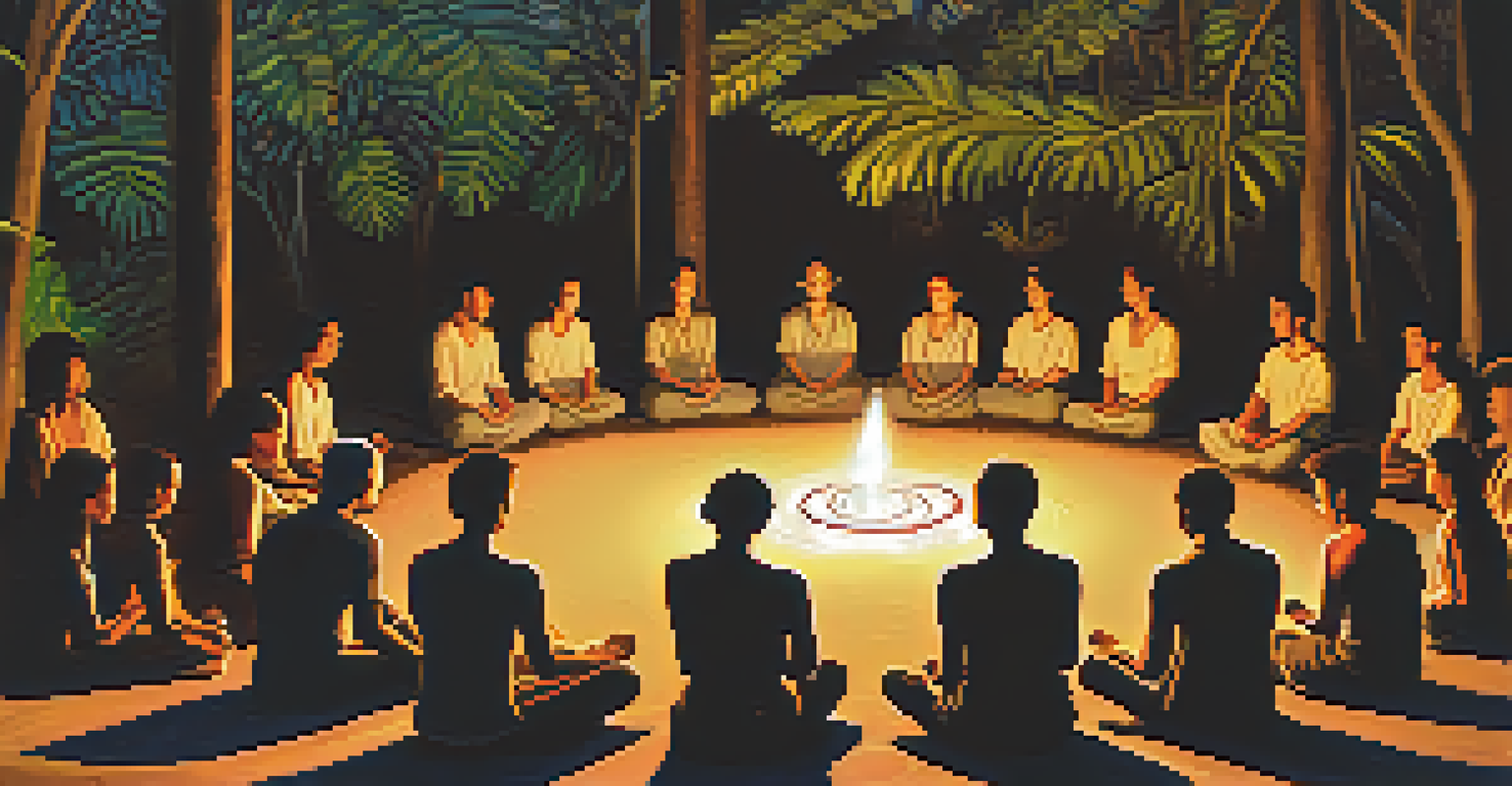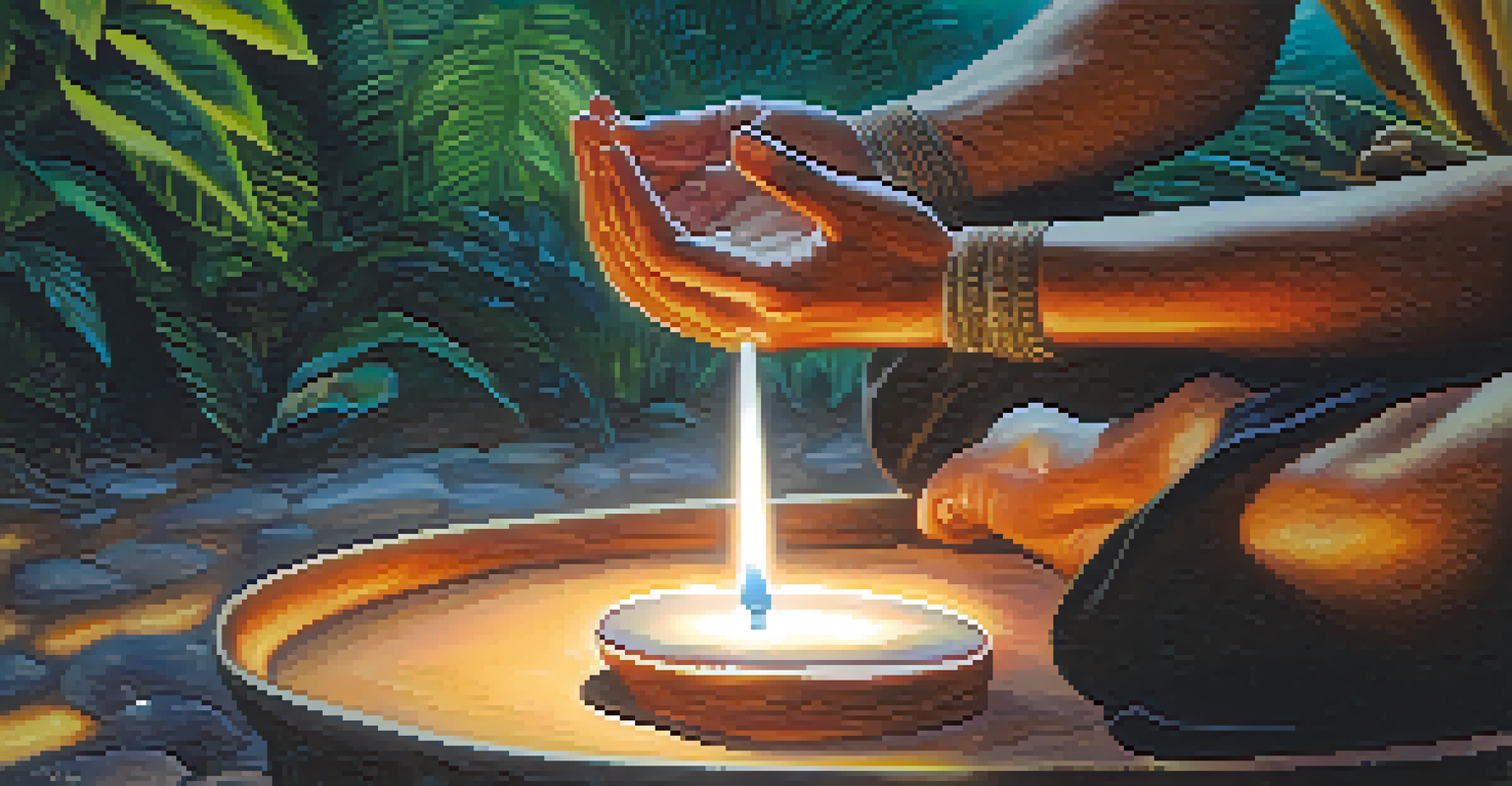Integrating Breathwork into Ayahuasca Rituals and Practices

Understanding Ayahuasca and Its Rituals
Ayahuasca, a sacred brew from the Amazon, has been used for centuries in spiritual ceremonies. It combines the Banisteriopsis caapi vine and the Psychotria viridis plant, creating a powerful psychedelic experience. Participants often seek healing, insight, and a deeper connection to themselves and nature through these rituals.
Breath is the bridge which connects life to consciousness, which unites your body to your thoughts.
The rituals surrounding Ayahuasca are as important as the brew itself. Typically guided by a shaman, these ceremonies involve singing, chanting, and a safe, supportive environment. This setting helps participants navigate their inner landscapes, often leading to transformative experiences that can impact their lives long after the ceremony ends.
However, the intensity of Ayahuasca can be overwhelming. This is where breathwork comes in, serving as a practical tool to help participants manage their experiences and foster a deeper connection with the spirit of the medicine.
What Is Breathwork and Its Benefits?
Breathwork refers to various techniques that involve conscious control of breathing patterns. These practices can enhance physical, emotional, and spiritual well-being, making them valuable in various contexts, including yoga, meditation, and even psychotherapy. By focusing on breath, individuals can access altered states of consciousness that promote relaxation and emotional release.

In the context of Ayahuasca, breathwork can significantly enhance the experience. It helps participants ground themselves, making it easier to navigate difficult emotions or overwhelming sensations. By regulating their breath, they can maintain a sense of calm, even in the face of intense visions or feelings that arise during the ceremony.
Ayahuasca Rituals Foster Healing
Ayahuasca ceremonies, guided by a shaman, create a supportive environment that encourages participants to seek healing and deeper self-awareness.
Furthermore, breathwork can facilitate deeper connections with the Ayahuasca experience. As individuals learn to breathe intentionally, they often find it easier to access insights and wisdom that emerge during the journey, allowing for a more profound, integrative experience.
Integrating Breathwork into Ayahuasca Preparation
Preparing for an Ayahuasca ceremony involves more than just abstaining from certain foods or substances; mental and emotional readiness is crucial. Incorporating breathwork into your preparation can help clear your mind and set positive intentions. Simple practices, such as diaphragmatic breathing or pranayama, can create a sense of calm and focus.
The journey of a thousand miles begins with one step.
Before the ceremony, participants might engage in guided breathwork sessions to become more attuned to their bodies and emotions. This practice not only enhances self-awareness but also helps release any anxieties or fears they may have about the upcoming experience. Feeling centered can make a significant difference in how one approaches the journey ahead.
Moreover, breathwork can help participants visualize their intentions more clearly. By connecting breath with intention, individuals can create a powerful mental framework that guides their experience, allowing them to delve deeper into personal insights and revelations during the ceremony.
Breathwork Techniques for Ayahuasca Ceremonies
During an Ayahuasca ceremony, various breathwork techniques can be employed to enhance the experience. One popular method is rhythmic breathing, where participants inhale deeply and exhale slowly in a rhythmic pattern. This technique can help maintain a steady energy flow and foster a sense of connection with the group.
Another effective technique is the '4-7-8' method, which involves inhaling for four counts, holding the breath for seven counts, and exhaling for eight counts. This practice not only calms the nervous system but also encourages mindfulness, keeping participants grounded as they journey through their Ayahuasca experience.
Breathwork Enhances Experiences
Incorporating breathwork into Ayahuasca rituals helps participants manage intense emotions and connect more deeply with their journey.
Guided breathwork, facilitated by the shaman or an experienced practitioner, can also be beneficial. These guided sessions can help participants navigate their emotional landscapes, offering support and direction as they explore the depths of their consciousness.
Breathwork During Ayahuasca Experiences
Throughout the Ayahuasca journey, breathwork can be a lifeline for participants. When faced with challenging visions or emotional turmoil, returning to the breath allows individuals to regain control and find their footing. Focusing on the breath can help create a sense of safety and stability amid the unpredictable nature of the experience.
This conscious breathing can also amplify the effects of Ayahuasca. Many participants report feeling more connected to their surroundings and experiencing deeper insights when they incorporate breathwork into their journey. The breath becomes a bridge to the spiritual realm, facilitating a more profound connection with the medicine.
Additionally, breathwork can serve as a tool for emotional release. By allowing oneself to breathe fully and deeply, participants can let go of pent-up emotions, fostering healing and catharsis. This process not only enriches the personal journey but also contributes to the collective energy of the group.
Post-Ceremony Integration with Breathwork
The journey doesn't end when the Ayahuasca experience is over; integration is a crucial phase. Breathwork plays a significant role in this process, helping participants make sense of their insights and emotions. Engaging in breathwork sessions post-ceremony can aid in grounding the experience and facilitating reflection.
Practices like journaling while focusing on breath can also be beneficial. This combination allows individuals to articulate their experiences, gaining clarity and understanding. Breathwork helps maintain a sense of calm and focus during this reflective period, enhancing the integration process.
Integration is Key Post-Ceremony
Post-ceremony breathwork supports participants in reflecting on their experiences, aiding in emotional grounding and ongoing personal growth.
Moreover, continued breathwork practice after the ceremony can encourage ongoing personal growth. By cultivating a regular breathwork routine, individuals can continue to explore their inner landscapes, promote healing, and foster a deeper connection with themselves and the world around them.
The Synergy of Breathwork and Ayahuasca
The combination of breathwork and Ayahuasca creates a powerful synergy that can elevate the entire experience. Breathwork enhances emotional awareness, grounding, and spiritual connection, making the journey more profound and meaningful. This partnership allows participants to navigate the often tumultuous waters of their inner experiences with greater ease.
As more people explore holistic practices, the integration of breathwork into Ayahuasca rituals is gaining popularity. This trend reflects a broader movement toward mindful, intentional healing practices that honor both tradition and personal growth. Participants are increasingly recognizing the value of breath as a tool for transformation.

Ultimately, the union of breathwork and Ayahuasca rituals can lead to deeper healing, insights, and lasting change. By embracing both practices, individuals can cultivate a richer, more fulfilling spiritual journey that resonates long after the ceremony has concluded.